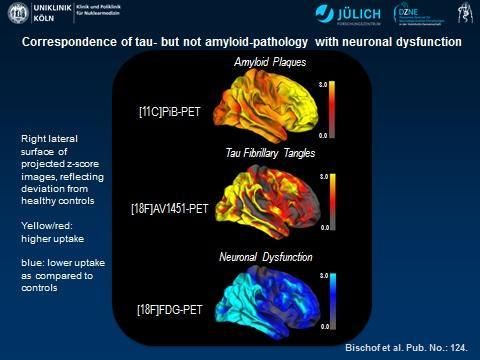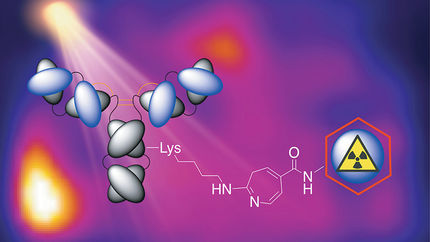PET points to tau protein as leading culprit in Alzheimer's
Alzheimer's is a devastating and incurable disease marked by beta-amyloid and tau protein aggregations in the brain, yet the direct relationship between these proteins and neurodegeneration has remained a mystery. New molecular imaging research is revealing how tau, rather than amyloid-deposition, may be more directly instigating neuronal dysfunction.

This image shows topographical correspondence of tau- but not amyloid-pathology with neuronal dysfunction in Alzheimer's disease. Right lateral surface of projected z-score images, reflecting deviation from healthy controls. Yellow/red: higher uptake, blue: lower uptake as compared to controls.
G. Bischof, J. Hammes, T. van Eimeren, A. Drzezg
Exhaustive brain research has pieced together how extracellular beta-amyloid plaques and intracellular neurofibrillary tangles of tau proteins are strongly linked to the neurodegenerative pathology of Alzheimer's disease. However, much of the research conducted to date has been post-mortem, which does little to help researchers understand the early development of disease. A new imaging study in living Alzheimer's patients is combining three methods of positron emission tomography (PET) to measure the orchestration of amyloid, tau and metabolic activity in the brain. Findings of the study showed a significant correlation between increased tau and decreased metabolic activity in the brain, a clear sign of neurodegeneration.
"Tau-imaging seems to be closely linked to actual onset of neuronal injury, whereas amyloid-imaging may allow us to detect a predisposition to disease many years ahead of the onset of symptoms," said Alexander Drzezga, MD, from the German Center for Neurodegenerative Diseases at the University Hospital of Cologne in Cologne, Germany.
For this study, 10 subjects with Alzheimer's underwent PET following the injection of three radiotracers: fluorine-18 fluorodeoxyglucose (F-18 FDG), which images regional metabolic activity; carbon-11 Pittsburgh compound B (C-11 PiB), which has an affinity for amyloid plaques; and F-18 AV-1451, an emerging imaging agent that binds to tau in the brain. Results showed that increased tau was directly associated with hypometabolism (reflecting neuronal dysfunction) in the brain. For amyloid-deposition, no strong association with hypometabolism was found. However, an indirect interactivity between tau and amyloid was observed particularly in the parietal cortex, in that the negative impact of regional tau-deposition on metabolism was stronger in regions with higher amyloid-burden.
"Integrating these molecular imaging tools offers the opportunity to investigate the possible independent and synergistic contribution of these protein pathologies in neurodegeneration in the living brain and, therefore, greatly advance our understanding of the mechanisms of Alzheimer's disease," said Drzezga.
Further investigation of these and other factors of neurodegeneration in living dementia patients could one day help clinicians improve diagnostic accuracy and lead to disease-modifying therapies for Alzheimer's, including new drugs that could potentially target tau in order to slow or stop degenerative effects in the brain. Multimodal imaging approaches like this one could allow more precise staging of neuropathology, even before the irrevocable onset of memory loss experienced by Alzheimer's patients. Furthermore, improved prediction, prognosis and therapy control/follow up may become feasible.
Most read news
Topics
Organizations
Other news from the department science

Get the life science industry in your inbox
By submitting this form you agree that LUMITOS AG will send you the newsletter(s) selected above by email. Your data will not be passed on to third parties. Your data will be stored and processed in accordance with our data protection regulations. LUMITOS may contact you by email for the purpose of advertising or market and opinion surveys. You can revoke your consent at any time without giving reasons to LUMITOS AG, Ernst-Augustin-Str. 2, 12489 Berlin, Germany or by e-mail at revoke@lumitos.com with effect for the future. In addition, each email contains a link to unsubscribe from the corresponding newsletter.



















































